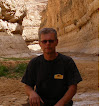12.01.2015
The journey: Museo Pachamama – San Miguel de Tucumán – El Cadillal (206 km).

From Wikipedia : Pachamama is a goddess revered by the indigenous people of the Andes. She is also known as the earth/time mother.
In Inca mythology, Pachamama is a fertility goddess who presides over planting and harvesting, embodies the mountains, and causes earthquakes. She is also an ever-present and independent deity who has her own self-sufficient and creative power to sustain life on this earth. Her shrines are hallowed rocks, or the boles of legendary trees, and her artists envision her as an adult female bearing harvests of potatoes and coca leaves.
Pachamama is the wife of Pacha Kamaq and her children are Inti, the sun god, and Killa, the moon goddess. The four cosmological Quechua principles - Water, Earth, Sun, and Moon - claim Pachamama as their primordial origin, and priests sacrifice llamas, cuy (guinea pigs), and elaborate, miniature, burned garments to her. After the conquest by Spain, which forced conversion to Roman Catholicism, the figure of the Virgin Mary became united with that of the Pachamama for many of the indigenous people. In pre-Hispanic culture, Pachamama is often a cruel goddess eager to collect her sacrifices. As Andes cultures form modern nations, Pachamama remains benevolent, giving, and a local name for Mother Nature. Thus, many in South America believe that problems arise when people take too much from nature because they are taking too much from Pachamama. https://en.wikipedia.org/wiki/Pachamama



